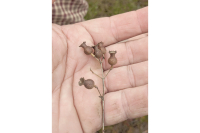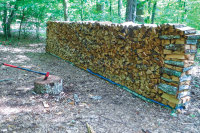Control from the top: WNC hunters attempt to curb coyote populations with hunt
 Mark Rogers sticks his hand through the cold air outside Bethel Grocery into the even more frigid interior of the standalone freezer settled beside the building along U.S. 276 in Haywood County. There’s a dead coyote inside, folded body hard and rigid through a combination of cold and rigor mortis. Rogers pulls it out into the sunlight, where bright rays bounce shine off its array of red, gray and white hairs.
Mark Rogers sticks his hand through the cold air outside Bethel Grocery into the even more frigid interior of the standalone freezer settled beside the building along U.S. 276 in Haywood County. There’s a dead coyote inside, folded body hard and rigid through a combination of cold and rigor mortis. Rogers pulls it out into the sunlight, where bright rays bounce shine off its array of red, gray and white hairs.
“That one’s actually got a pretty coat on it,” says Cheyenne Keener, who owns Cheyenne’s Corner, a nook inside Bethel Grocery selling guns and other hunting supplies.
In all likelihood, the fur will someday end up adorning a coat hood in China or Russia, said Rogers, a longtime coyote trapper and member of the Western North Carolina Sportsman’s Club. Each coyote he traps earns him $30 to $40 from its sale to the Wisconsin-based North American Fur Auction.
People like the fur. But, by and large, they don’t like the animal, which the N.C. Wildlife Resources Commission considers an invasive and is blamed for the deaths of deer, dogs, cats and calves alike. They’re running rampant, and something needs to control them, many say. That’s why Rogers started up the WNC Sportsman’s Club Coyote Contest. They’ve done it three out of the past four years with a goal of exterminating as many coyotes as possible.
“We’ll never ever be rid of them, and I think really the only thing to do is to try and control the numbers,” Rogers said.
Last year, the contest brought in about 40 dead coyotes. Each coyote earns its hunter a ticket for a prize drawing, with the first-, second- and third-place hunters automatically winning prizes such as gift cards and tickets to the National Wild Turkey Federation banquet. To enter all a hunter needs to do is bring the coyote by Bethel Grocery or Shed’s Hunting Supply and, if desired, leave the carcass behind for use in a rabies study the U.S. Department of Agriculture is conducting.
Related Items
With a contest deadline of Feb. 27, the tally so far is a good bit lower than last year’s total, 14 as of Feb. 12. There don’t seem to be as many coyotes about this year, but that’s likely not an indicator of the strength of the overall population, according to Justin McVey, district biologist for the Wildlife Commission.
“Populations wax and wane,” he said. “They’re never steady.”
Roger’s lifetime tally for coyote is 30. It’s a number he’s worked hard for — trapping a coyote is no easy feat.
“Catching a coyote would be to me like a trophy buck because there’s that level of challenge,” Rogers said. “I have a lot of respect for them. I don’t hate them or anything like that.”
Thought goes into where the traps are set, how they’re set and measures the hunter takes to control the human scent on them. Then, the traps have to be checked daily to determine whether anything’s been snagged. Non-target animals can be turned loose without injury, but if a coyote’s caught in the trap then Rogers had about an hour’s worth of work ahead of him to kill and skin it.
Some people opt to bring them in with calls instead, purchasing a contraption that puts out a noise like a wounded rabbit to attract the coyotes. That can be a more challenging tack to take, Rogers said.
“I think a lot of them comes in here will come to the calls, but being thick and forested you can’t see them at a long distance,” he said, “so once they get close they smell your scent. They’re super sharp animals.”
The coyote’s intelligence and general grit are undisputed, and while most hunters are eager and willing to shoot one whenever possible, the animal’s tenacity has earned it grudging admiration as well. Just like the Appalachian stalwarts who hunt it, the coyote is a survivor, a tough and cunning being that will make the most out of even the worst situation.
“Even though we do shoot them, I got a lot of respect for them,” said Raymond Bunn, manager at Shed’s Hunting Supply in Sylva, as he pulled down the tailgate on the truck parked outside the store. A pair of coyotes sat in the back, shot in the wee hours of the morning at his home near Dillsboro.
Bunn uses bait to attract his coyotes. He puts out old food scraps, anything likely to entice a coyote, and waits for the animals to come. He does it because he enjoys hunting, but like most people who go coyote hunting, there’s a public service mentality involved as well.
“I enjoy hunting and also feel like it’s trying to help somewhat to keep a population down,” Bunn said.
Coyotes eat just about everything, hunters explain, but what eats the coyotes? Nothing. They need a predator.
“They’re not bad animals as long as you control the population, just like any other animal,” said 26-year-old Robert Minton, of Waynesville. Minton, stopping by Bethel Grocery, had just shot two coyote near his hunting cabin in Wilkes County. Not for the hunting contest — just because he wanted to protect the area’s deer population.
It sounds like a simple formula. The more coyotes you kill, the fewer there will be, resulting in less predation on game species. And with most animals, that’s just how it works — but not with coyotes.
“One of the really unique things about coyotes and one of the reasons they are so adaptable is that the more you kill them or persecute them, the more they reproduce,” explained Ben Prater, regional director for Defenders of Wildlife.
It’s called “compensatory reproduction” — when a coyote population experiences increased pressure from hunting, it responds by producing larger litters more often.
“It’s (hunting is) not going to have an impact on the population. In fact, it could have the unintended consequence of only increasing it because of that adaptation,” Prater said.
McVey disagreed with Prater’s conclusion but acknowledged the impact of the coyote’s adaptation.
“It (hunting) can definitely help, but it has to be a really intensive effort coupled with trapping,” he said, adding that actually eradicating the species is probably out of the question.
If there’s one point everyone can agree on, it’s that one.
“They’ll always be here,” Rogers said.













